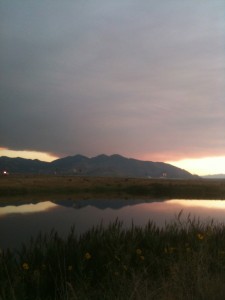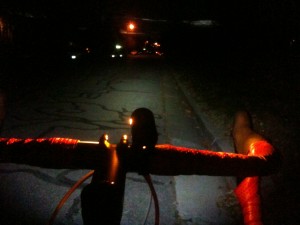
being home by dark.
By Dave Iltis
This summer was hot in Salt Lake City. With over 60 days above 95 degrees, the heat wilted flowers and cyclists alike. Many choose to escape to the Wasatch Mountains or the somewhat cooler trails and roads in Park City and the Wasatch Back. But that usually requires driving, and that is usually the last thing I want to do.
I’m an admitted night owl, and generally proud of it. So, riding early in the morning to escape the heat is something that rarely happens. I’d rather ride later in the day when the temperatures cool. And, since I’m usually working during the day to bring you the best in cycling information, I often don’t get to ride until later on in the day when sunset approaches, whether it’s summer or winter. But, I like to ride, so what is one to do?
This year, I’ve added something new to my cycling – lights! Sure, we all use them (or should be using them) for commuting around town. They help us be seen by cars and come home safe and sound. This year, I added them to my road bike – the carbon fiber one that I don’t leave locked up in front of the grocery store.
Late this summer, I started out on a ride from my home in the Avenues and headed west. It was 6:30 pm, and I wanted to ride. I ventured out along 3rd Ave to N. Temple, checking out the new bike lanes on the new N. Temple Grand Boulevard reconstruction. And kept going. To the Airport Bike Path, the International Center, and on out to the I-80 Frontage Road. I stopped along the way to help a couple of women adjust their bikes. Both were on borrowed bikes and riding for the first time in years.
I stopped a few more times to take photos, and to note the pavement repairs on the very worn concrete section around 7200 West. Salt Lake City recently patched most of the potholes and divots on this stretch, and the riding, while still a bit bumpy is much safer than it used to be. There’s still a deep rut in the center of the roadway, but that can be avoided without too much difficulty.
I kept riding and saw a few riders up ahead, so I put my nose down and rode hard for a couple of miles to catch them. The three were out enjoying the early evening on one of the most popular cycling roads in Salt Lake County. We road together for a few more miles until we reached Utah’s Taj Mahal, otherwise known as Salt Air. It was getting close to sunset. They turned around, and I kept going on to the Marina.
I stopped there and admired the view of Antelope Island and the Great Salt Lake from the viewing station at the end of the road, then filled my water bottles and set off back to Salt Lake City.
The ride from the Marina to the Avenues is about 21 miles each way. With around 15 miles to go, the sun had set, and I was riding in the increasing darkness. In year’s past, I ended up in situations like this because of bad planning – start late, ride home in the dark without a light, stick to the quiet streets and ride very carefully. This year, I just press a button, and, Fiat Lux. I can see the road, cars can see me, and I can ride, fast, after the sun goes down. Lights have become more and more powerful, and are easier to mount on your bike than they used to be. I have a set of Light & Motion Urban commuting lights. They are bright – 550 lumens in the front, and a pulsing red rear light so I can be seen from behind. They are bright enough so that I can see the road in front of me, even when cruising at 25 mph (and even up to 32 or so on some steeper descents). Since my carbon bike has an aero post, standard brackets won’t easily work. The rubber mounting straps make this easy – no brackets needed.
Mountain bikers have been doing this for a number of years – training for 24 hour races and escaping the heat. Road riders tend to come home when it’s dark.
Riding in the evening and at night is cooler in the summer, and there’s less traffic.
This year, I no longer feel tied down by the sun. I can avoid the heat. I can find time to ride even when I’m too busy during the day. Or, when the morning people’s conspiracy known as standard time starts up in the fall, I can ride after work and into the evening.
Some of the rides I’ve done in the dark include Emigration Canyon, City Creek, the Salt Lake Marina, and the Legacy Parkway – Jordan River Parkway.
Can lights change your life? They may not help you organize your house or fix your car, but they can change how you ride.
Light Review:Light and Motion Urban 550 combo kit

The kit comes with a front 550 lumen light, and a pulsing rear light. The front light has 4 settings and associated battery life: 550 lumens, 1:30; 275 lumens, 3:00; 140 lumens, 6:00; 140 lumens flashing, 18:00. For the type of riding I have been doing, I prefer the 550 lumen setting as it provides plenty of light to see the road at 20-30 mph. The front light can be mounted to the handlebar (my preference), or with the provided mounting bracket to your helmet.
The VIS 180 rear light emits a pulsing rear facing red light with amber side lights, which according to Light & Motion does not attract cars as much as blinking rear lights. The light never shuts off completely, but rather brightens and dims. The rear light is 25 lumens, and the run time ranges from 6 to 20 hours depending on the setting. The sidelights give 180 degrees of visibility, hence the name VIS 180.
Charging for both lights is by a micro-USB cable that works with any computer, or can be used with an adapter in an outlet. Because the run time is shorter than less powerful lights, one must remember to plug in the light after every use or two to ensure leaving the house with a full charge. This required a little more attentiveness.
The rubber mounting straps work well, even with larger diameter bars and odd-shaped aero seatposts. They are easy to use, which is great when stopping off at a store or restaurant.
The combo kit retails for $180. The lights come with a 2 year warranty.
I really like this set of lights. I rate them Hors Categorie (5 stars). For more information, visit: lightandmotion.com.







